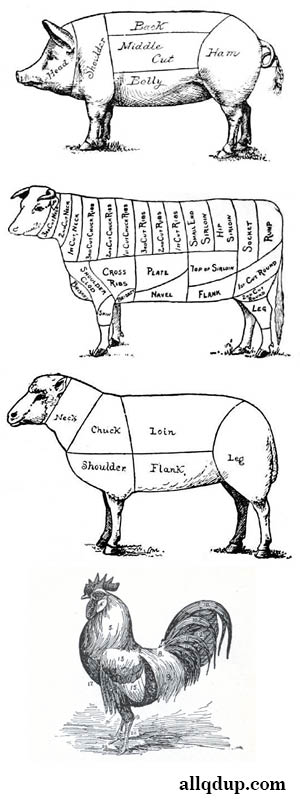Wild game birds are classed by age. According to the USDA, game species raised on farms under appropriate regulations can be sold. Wild game species that can be legally hunted under Federal or State regulatory authority cannot be sold, but can be harvested for personal consumption.
For ducks and geese, grading is voluntary and a plant pays to have its ducks or geese graded. The presence of the USDA Grade shield, usually Grade A, on these products is an indication of quality. USDA Grade A ducklings are the highest quality available. They are plump, meaty and have skin free from cuts, bruises and tears. There are no broken bones, no missing parts and few pin feathers. Grade B and Grade C ducklings are not usually found in supermarkets.
Are Game Birds Red Meat or White Meat?
Game birds are poultry and considered “white” meat, except for ratites. But because they are birds of flight, their breast meat is darker than domestic chicken and turkey because more oxygen is needed by muscles doing work, and the oxygen is delivered to those muscles by the red cells in the blood. But it looks like “red” meat.
According to the FAQs from Maple Leaf Farms, a commercial duck farm:
If duck is poultry, why does it look more like red meat?
While duck is poultry, it is very different from chicken and turkey, because it’s a red meat. There is no white meat on duck. This means that a well-prepared duck breast eats more like steak than chicken and is slightly pink in the center when properly cooked to an internal temperature of 160 degrees F.
The USDA classifies the Ratite class (ostriches, emus, and rheas) as a “red” meat:
Although ratites are poultry, the pH of their flesh is similar to beef. Therefore, they are classified as “red” meat. The raw meat is a very dark cherry red. After cooking, the meat looks like beef and the flavor is similar but a little sweeter. According the USDA, since ratites are classified as red meats, steaks and roasts can be safely cooked to 145 degrees F., but all ground meat should be cooked to 160 degrees F to be safe to eat.
Cooking Game Birds
Poultry and wild game bird cookery, along with their classifications, is based on the age of the bird. The younger the bird, the more tender they are, and the more cooking methods there are to choose from. The older birds will have more pronounced flavors, darker meat, and in wild game birds more of a pronounced ‘game-bird’ flavor. The older and more mature birds may also require long, slow or moist-heat cooking methods. All game birds will typically have less fat that domesticated poultry.
As with all poultry items, wild game and domestic game birds are recommended by the USDA to be cooked to at least to 165 degrees F. According the USDA, fully cooked game birds may be eaten ‘red’ if completely cooked. Cooked muscle meats can be pink even when the meat has reached a safe minimum internal temperature.
If fresh duck or goose has reached a safe minimum internal temperature (165 degrees F. as measured with a food thermometer) even though it may still be pink in the center, it should be safe. The pink color can be due to the cooking method or added ingredients. Ratite whole cuts ONLY may be cooked at a lower temperature due to their red meat classification. For reasons of personal preference, consumers may choose to cook poultry to higher temperatures.
Since ducks and geese swim, they have a layer of fat under their skin to help keep them buoyant. This layer isn’t ‘marbled’, and can be removed before cooking. If roasting whole, as in the whole bird or a whole breast, the skin is typically pricked all over to help with fat rendering, which must be melted and gone for the bird to be ‘done.’
Game Birds and Their Classifications
CHICKEN
- Chicken is not a ‘game bird.’ See Chicken Classification for chicken classifications, including broilers, fryers, roasting chickens, capon, stewing hens and cock or rooster roasters. Cornish game hens and Rock Cornish game hens are actually a chicken.
DUCKS
- Broiler Duckling or Fryer Duckling – a young duck (usually under 8 weeks of age) of either sex. These have a soft bill and soft windpipe. These have tender meat. Ducklings classified as broiler-fryers weigh from 3 to 6 1/2 pounds.
- Roaster Duckling – a young duck (usually under 4 months old) of either sex. These have a bill that’s not completely hardened, and a windpipe that is easily dented. The meat is tender, and they weigh from 4 to 7 1/2 pounds.
- Mature Duck or Old Duck – a duck (6 months or older) of either sex. Tough meat. These have a hardened bill and a hardened windpipe. Usually too old to lay eggs, their meat is used in processed products.
EMU
- See Ratites.
GEESE
- Gosling – May be of either sex. A gosling weighs about 8 pounds.
- Young Goose – An immature duck of either sex. A young goose weighs 12 to 14 pounds.
- Mature Goose or Old Goose – may be of either sex. These have tough meat. A mature goose is usually a spent breeder, and its meat is used in processed products.
- Gander – a male goose.
GUINEAS
Guineas may be of either sex, although the females are typically more tender. Guineas gain a more gamey flavor as they age.
- Young Guinea – An immature guinea of either sex. Tender meat with a flexible breastbone cartilage.
- Old or Mature Guinea – An adult guinea of either sex. Tough meat with a nonflexible breastbone.
OSTRICH
- See Ratites.
PARTRIDGE
- Partridges are smaller birds generally prepared and served as 1 bird per person. Not common commercially, the younger partridges will be tenderer than the older birds.
PHEASANT
- Females generally have more tender meat than males, and are smaller (3 lbs. for the female vs. 5 lbs. for the male). Cooking methods depend on age: younger pheasant can be oven roasted but older pheasant has tougher and leaner meat making it suitable for moist heat methods.
PIGEONS
- Squab – Young, immature pigeon under 4 weeks of either sex, and usually under a pound in weight. Its meat is lighter than older pigeon and very tender since it hasn’t flown yet. Great for all cooking methods including grilling, roasting, pan frying and even sautéed and served as appetizers.
- Pigeon – Older pigeons, typically over 4 weeks of age. These are generally 1 to 2 lbs. The meat is darker and tougher than squab, with coarse skin.
QUAIL
- Quails are generally the smallest of all the game birds (under 8 ounces as ready to cook). Quail is generally served whole and oven roasted.
RATITES
Ostrich, Emu, and Rhea are in the ‘ratite’ family – flightless birds with small wings and flat breastbones. The meat is sold as steaks, fillets, medallions, roasts, and as ground meat. The most tender meat comes from the thigh. The birds are 95 percent usable (meat, feathers, oil, and leather). Ratites are typically slaughtered at around 10 to 13 months of age.
- Emu – Emu are native Australia. Emu reach about 6 feet tall and up to 140 pounds.
- Ostrich – The largest birds in the world. Ostriches are native to Africa, and stand about7 to 8 feet tall fully grown, and can weigh up to 400 pounds.
- Rhea – Rhea are native to South America, and can reach up to 5 feet tall and with about 60 to 100 pounds.
RHEA
- See Ratites.
TURKEY
Turkey meat is commonly sold as whole, breasts only, wings, legs and ground. Each class is based on age and can refer to either sex, unless labeled as ‘tom’ (male) or ‘hen’ (female).
- Fryer/Roaster – Turkeys under 12 weeks of age. The flesh is very tender, and great for all cooking methods.
- Young Turkey – Turkeys under 6 months old. Tender meat. Young turkeys can be found as ‘young tom’ or ‘young hen’ referring to the sex of the bird.
- Yearling – Turkeys under 15 months of age. This fully mature turkey is still young enough to have reasonably tender meat. Yearlings are found in a great weight range, from 10 to 30 lbs., and can be of either sex.
- Mature Hen (Female) or Old Tom (Male) Turkey – Adult turkey over 15 months of age. Tough meat and coarse skin. Great weight range, theses turkeys can be found from anywhere between 10 to 30 lbs.
Resources:
“Duck FAQ – Commonly Asked Duck Questions – Maple Leaf Farms.” Duck FAQ – Commonly Asked Duck Questions. Maple Leaf Farms, n.d. Web. 23 June 2014.
Poultry-Grading Manual. USDA Agricultural Marketing Service, 1998. Print. Agriculture Handbook Number 13.
USDA FSIS. Duck and Goose from Farm to Table. United States Department of Agriculture Food Safety and Inspection Service, 2011. Print.
USDA FSIS. Game From Farm to Table. United States Department of Agriculture Food Safety and Inspection Service, 2011. Print.
USDA FSIS. Ratites (Emu, Ostrich, and Rhea). United States Department of Agriculture Food Safety and Inspection Service, 2011. Print.



 Welcome to All Q’d Up. Dedicated to the art of barbecue.
Welcome to All Q’d Up. Dedicated to the art of barbecue. 